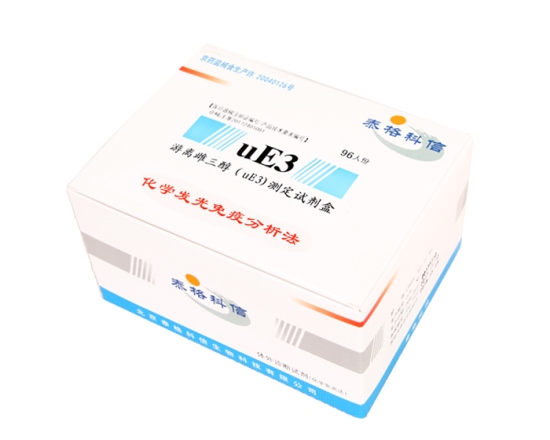

Detection kit for free estriol (uE3)

【Product Name】Detection kit for free estriol (uE3) (enhanced chemiluminescence immunoassay
【Registration certificate number】 京械注准20172401081
【Packing】48 tests/box,96 tests/box.
【Storage conditions and validity】Storage at 2 ~ 8℃,validity for 6 months.
This kit is mainly used for quantitative determination of free estriol (uE3) in human serum in vitro.
Estriol (E3) is an 18 carbon steroid hormone with a molecular weight of 288D. It is generally believed that E3 is a metabolite of E2 which is excreted by the kidneys through the urine after being bound to glucuronic acid or sulfuric acid in the liver. In middle-late pregnancy, the placenta synthesizes large amounts of E3, in the late pregnancy, 90% of the E3 is derived from the placenta. It is synthesized by the fetus, placenta and the mother together. The activity of E3 is much weaker than that of E2 and the physiological role of E3 is similar to that of E2 in nonpregnant women. The main physiological role of E3 during pregnancy is to increase blood flow between uterine placenta through the production of prostaglandins, it also nourish the fetus. Determination of serum free E3 content can help to assess the unit function of placenta-fetal, it plays great role in monitoring pregnancy-induced hypertension, diabetes and other high-risk pregnant women.
This kit uses competitive approach. The reagents used in the kit are E3 standard, horseradish peroxidase labeled E3 (HRP-E3), microplate coated with E3 antibody, chemiluminescent substrate (with enhancer), enzyme-labeled antigen competes with unlabeled antigen (antigen of test sample) for coating a limited number of wells binding site of the specific antibody in the microplate and combines into antigen-antibody complex, the number of unlabeled antigen (antigen of test sample ) affects the number of antigen-antibody complex, the more antigens in the sample to be tested, the less labeled antigen-antibody complex formed. Unbound labeled antigen is removed after the immune reaction, it cancan produce optical signals by adding chemiluminescent substrate, the optical signal will decrease with the increase of antigen in the sample to be tested. According to the relative luminescence intensity of E3 series and its concentration, the dose-response curve can be drawn by log-logit mathematical model or other suitable mathematical model fitting and the content of E3 in the tested sample can be calculated from this curve by the relative luminescence intensity.
When the estriol decreased and the estradiol increases in serum, it is suggested that the placenta is malfunctioning and often indicates premature birth. Pregnancy-induced hypertension syndrome, pre-eclampsia and fetal intrauterine growth retardation, expired pregnancy, fetal intrauterine asphyxia, hydatidiform mole, fetal congenital malformations, intrauterine demise, and so on will show a decrease in the content of free estriol.